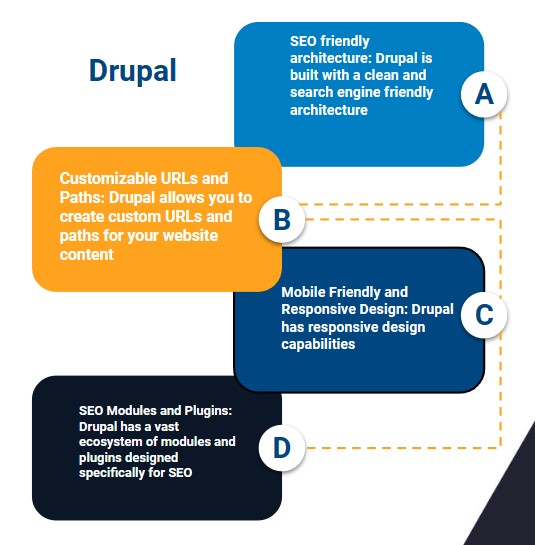
In today’s digital-first world, a secure, user-friendly, and scalable website is essential for banks aiming to build customer trust and deliver seamless online experiences. For banking institutions exploring web development technologies, Drupal web development often stands out as a strong contender.
With its powerful content management capabilities, robust security features, and flexibility, Drupal has become a preferred choice for creating complex, high-traffic websites, including those in the financial sector. But is Drupal the right fit for a banking website? Let’s explore why Drupal web development could be a strategic decision for your bank's online presence.

Understanding the Requirements of a Banking Website
Before delving into why Drupal might be the right solution, it’s crucial to consider the unique requirements of a banking website:
- Security: A top priority for any financial institution. Banking websites handle sensitive customer information and must comply with stringent regulations like PCI-DSS (Payment Card Industry Data Security Standard).
- Scalability: Banks often deal with high volumes of traffic and need a platform that can scale smoothly as they grow.
- Performance: Fast load times and a smooth user experience are essential. Customers expect 24/7 access to their accounts, seamless transactions, and quick information retrieval.
- Customizability: A banking website needs custom features like online banking portals, secure customer communication channels, and multi-tier user management.
- Compliance and Accessibility: Banks need to comply with accessibility guidelines (like WCAG 2.1) and legal standards to ensure all users, including those with disabilities, can access their services.
Given these demands, any platform used for banking web development must be secure, flexible, and robust enough to handle complex needs. This is where Drupal web development comes into the picture.
Why Drupal Web Development is a Strong Choice for Banking Websites
1. Unmatched Security
Security is the foundation of any banking website. One of the primary reasons why Drupal web development is favored by government agencies, healthcare institutions, and financial organizations is its strong emphasis on security. Drupal has a dedicated security team that monitors, identifies, and patches vulnerabilities. The platform also supports granular user access controls, ensuring that sensitive information is only accessible to authorized users.
Additionally, Drupal’s robust community-driven development means that security issues are addressed swiftly. With regular updates and an active community, the platform stays ahead of potential threats, reducing the risks of data breaches—a critical aspect for any banking institution.
2. Scalability and Performance Under Heavy Load
As banks expand their customer base, they need a platform that can grow with them. Drupal is designed for scalability, capable of supporting websites that handle millions of users. Whether it’s a small regional bank or a global financial institution, Drupal can be customized to meet growing demands without compromising on performance.
Drupal’s caching mechanisms, content delivery network (CDN) integrations, and ability to manage high volumes of content efficiently make it a top choice for websites that require fast load times even under heavy traffic. For banks that run large marketing campaigns or offer digital services to thousands of users simultaneously, performance is crucial—and Drupal delivers on this front.
3. Flexibility and Customization
Every bank has its unique needs when it comes to online services. Drupal’s modular architecture allows developers to build highly customized websites tailored to specific business objectives. For example, a bank might need separate sections for retail banking, corporate banking, and wealth management, each with distinct user journeys and functionalities.
With Drupal, you can create personalized user experiences based on customer data and behavior, offering a tailored digital experience for each user. This is particularly important for banks aiming to provide personalized financial advice or targeted product recommendations based on a customer’s profile.

4. Content Management and Multilingual Capabilities
For banks operating in multiple regions or serving diverse customer bases, managing content in different languages and ensuring consistent brand messaging across regions can be a challenge. Drupal excels in multilingual support, allowing seamless content management across languages. Additionally, Drupal’s content management system (CMS) is highly intuitive, enabling marketing teams to create, update, and manage content efficiently without relying on developers.
This level of control is crucial for banks that need to quickly respond to regulatory changes, update customers on new products, or share financial insights through blogs and resources.
5. Compliance and Accessibility
Financial institutions are held to strict compliance and accessibility standards. Drupal’s flexibility allows for the integration of accessibility tools and compliance frameworks. Whether it’s meeting WCAG 2.1 standards for users with disabilities or ensuring GDPR compliance for data protection, Drupal provides the necessary tools to align your website with legal and regulatory requirements.
This makes it easier for banks to create websites that are not only legally compliant but also inclusive, ensuring that every customer can access and interact with their services.
6. Seamless Integrations
A banking website often needs to integrate with third-party systems such as CRM platforms, payment gateways, and core banking systems. Drupal’s API-first approach and extensive library of modules make it easy to connect with various external systems, enabling smooth data exchange and consistent functionality.
Whether it’s integrating a secure payment portal or linking customer data with your CRM, Drupal’s modular structure provides the flexibility needed to enhance digital banking services.

Case Study: Drupal in Action in the Financial Sector
To understand the real-world impact of Drupal web development in the banking sector, consider the case of the National Bank of Canada. The bank needed a platform that could handle complex workflows, deliver personalized content, and ensure top-tier security. By choosing Drupal, they were able to build a website that not only met their high standards for security and compliance but also offered a scalable solution for future growth.
Drupal enabled the National Bank of Canada to provide seamless customer experiences across multiple devices, manage extensive multilingual content, and integrate various backend systems—all while maintaining strict security standards. This case is a clear example of how Drupal’s capabilities align with the needs of modern financial institutions.
Choosing Drupal for Your Bank’s Website
When it comes to selecting the right technology for your bank’s website, it’s important to consider both your immediate needs and long-term objectives. Here’s why Drupal web development could be a perfect match:
- Security: With its extensive security features and regular updates, Drupal offers peace of mind in protecting sensitive financial data.
- Customization: The ability to create tailored digital experiences ensures that your website can be as unique as your banking services.
- Scalability: Whether your bank serves a local community or a global customer base, Drupal can scale alongside your growth.
- Compliance: Easily integrate regulatory compliance measures and accessibility features to ensure your site meets all necessary standards.
- Performance: Maintain fast load times and a smooth user experience even during peak traffic periods.
For banks aiming to provide secure, innovative, and customer-centric digital experiences, Drupal web development offers a robust, reliable, and future-proof solution.
In an industry where trust, security, and seamless service are paramount, the choice of web development platform is critical. Drupal’s proven track record in handling the complexities of high-stakes industries, combined with its flexibility, security, and scalability, make it an ideal choice for banking websites. As you consider the next step in your bank’s digital transformation, leveraging Drupal web development could be the key to delivering a secure, efficient, and engaging online experience that meets the needs of today’s digital-savvy customers.
By investing in a Drupal-based solution, banks can build not just a website, but a digital ecosystem that enhances customer relationships, drives growth, and positions them for success in an increasingly competitive market.
We recommend you on video


